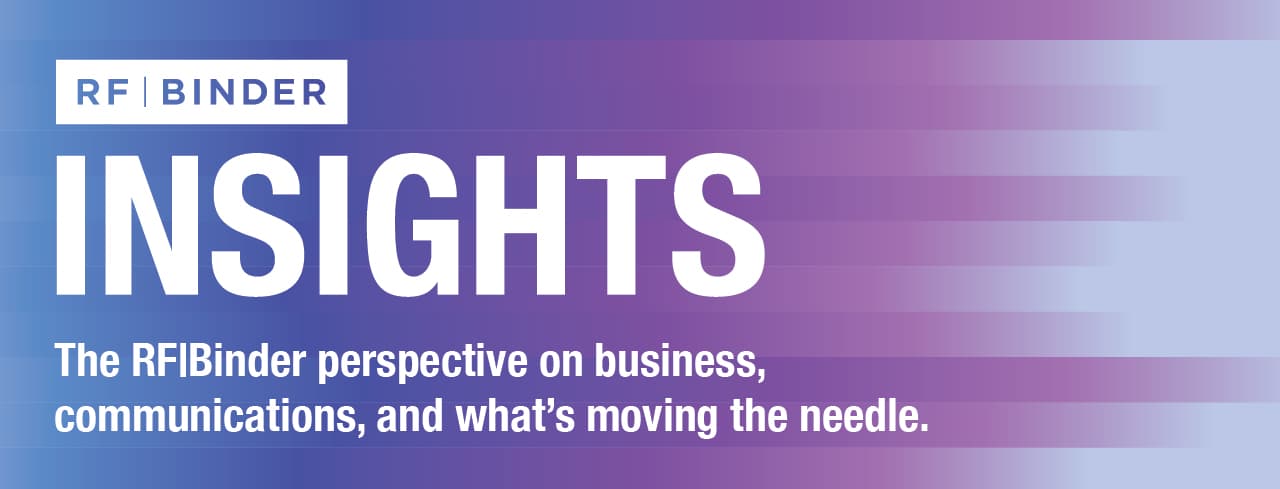In honor of International Women’s Day and Women’s History Month, RF|Binder hosted a virtual “Hour to Empower” session on Bias in the Media with Mitra Kalita, former journalist, media executive, prolific commentator, and author.
Mitra comes from the integrated world of news media – having worked on both the editorial and business side – including holding leadership positions at CNN, Quartz, and the Wall Street Journal, to name a few.
She publishes her own series of newsletters (Epicenter, The Escape Home, The Unmuted) and is the cofounder of URL Media, a network of Black and Brown community news outlets that share content and revenue.
Needless to say, we were eager to hear her perspective on the topic and how to apply it to our daily work for our clients. Here are some of the insightful takeaways from the conversation.
Rethinking What Bias Means
While we are often quick to assume politics and partisanship when we think about bias, it’s important to remember that not all bias is necessarily bad. We come to our personal and professional lives with varied experiences and opinions that shape our world view and help us make critical decisions. Yet those biases can extend farther than we realize. For example, many of us take the parameters of our daily lives for granted. For BIPOC, their experiences are often forced to mold into preexisting White, English-speaking notions of work and society. We must maintain awareness of what we believe to be true and how those truths may appear different for others.
When thinking about bias in the news media specifically, there has been an evolution of the idea of “objectivity” to “fairness” over the past few years. Yet, it’s important to understand that there can never be full neutrality. For example, in the wake of the revived social justice movement around Black Lives Matter, this became even more clear as reporters navigated how to report on such issues through the news of the day while considering the lens of the Black experience in America.
Diversifying the Newsroom to Diversify Coverage
To ensure media companies can report with a diverse perspective, it is critical to diversify the newsroom itself. Mitra launched a B2B service through URL Media that placed candidates, mostly of color, through executive recruitment and placement, as well as providing career coaching for BIPOC communities. The program has resulted in placements across editorial newsroom jobs as reporters and editors. There is still more work to be done – according to 2016 analysis from Pew Research Center, just 23% of newsroom employees were people of color, while 61% of newsroom employees were men.
This raises the issue of the responsibility put on specific people to report on certain topics because of their experience. For example, women are often asked to report on pay equity in the workplace or Black people are asked to report on the Black experience in America. Media companies cannot expect their reporters and editors to make diversity their beat, yet diverse voices bring different lenses and approaches to a story, resulting in stronger, more comprehensive storytelling. According to the World Economic Forum, “more diverse and inclusive newsrooms and coverage can provide better representation of societies, build audience trust and even make news organizations more profitable.”
Addressing Bias as Strategic Partners
There is a level of risk associated with any external communication and how bias on either side – the reporter or the spokesperson – can cloud the story. As strategic communicators, it is our responsibility to coach our clients through potentially difficult questions and discuss with them how to address bias that might surface in interviews. It’s also critical to be mindful of the language and words we use as they can be loaded with unintended meaning depending on the perspective or bias one brings to the conversation.
For example, many women executives are still asked about their families and personal lives when profiled in the media. In some instances, this can paint one picture of what it’s like to be a woman leading a company – but other times, it can be a distraction from the true focus of the story which might be where the brand is headed, product innovation, or other company priorities. It’s important to consider the overall angle and how both the interviewer and interviewee feel about the direction of the story ahead of an interview.
The Importance of Relationships and Authenticity
Relationships are foundational in media relations – this we know well. However, understanding the different perspectives we bring to our work in communications and being aware of our own biases is as important as ever as we strive to build meaningful connections and represent our clients to reporters. We must better understand how the newsroom operates, what stories will be impactful, and what distinct value our clients and their executives can bring to the conversation.
Authenticity has become a buzzword for companies telling their stories. To drive business outcomes. communications professionals are tasked with getting their client’s story told in a way that is engaging for an outlet’s audience. In order to do that, it’s critical to identify the core value the company or brand brings to the ongoing conversation and communicate that to reporters with a clear perspective.
Recognizing our own biases, respecting others’ perspectives, and counseling our clients along the way is essential today and will become more paramount in the future as news media continues to rapidly evolve.
RF|Binder hosts Hour to Empower sessions on a quarterly basis, bringing in a diverse mix of speakers and thought leaders to inspire reflection, strike up meaningful conversations with our colleagues, and drive impact for our clients.

